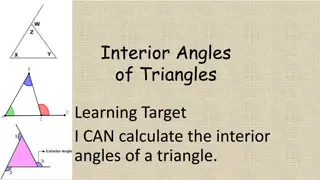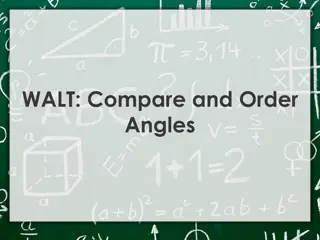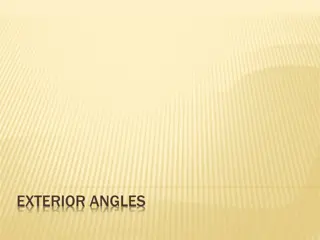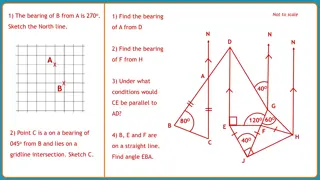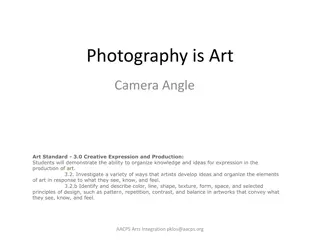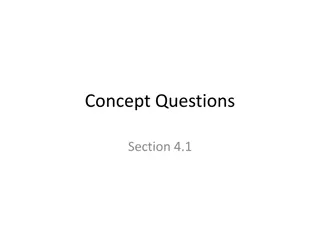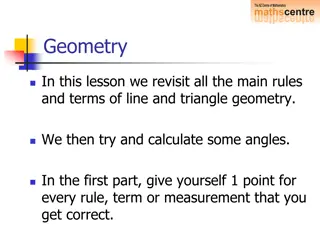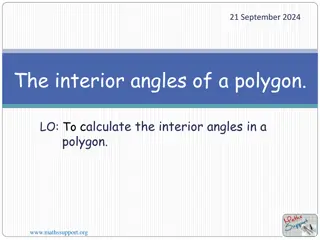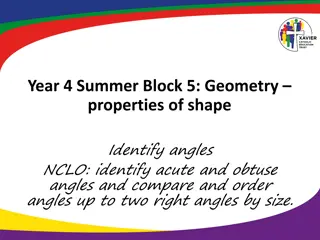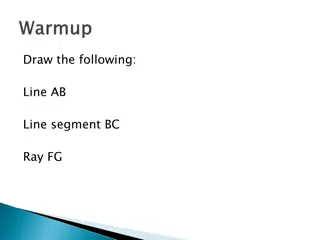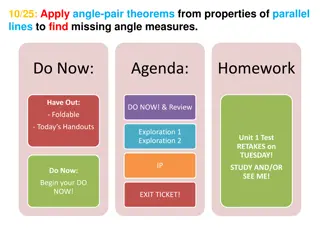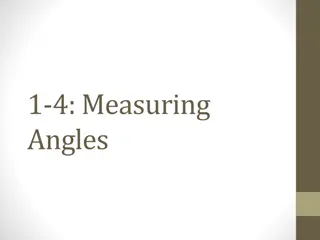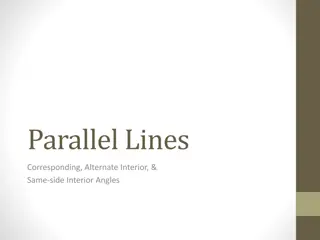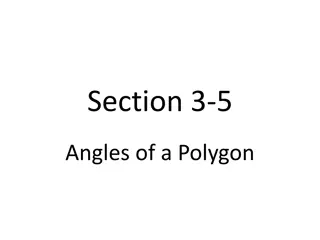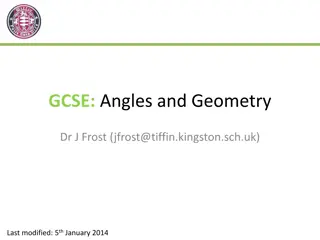
Understanding Angles - All You Need to Know
Dive into the world of angles with this comprehensive guide covering angle formation, measurement, types (acute, obtuse, right), complementary and supplementary angles, and more. Explore visual explanations and examples to enhance your understanding of this fundamental geometric concept.
Uploaded on | 2 Views
Download Presentation

Please find below an Image/Link to download the presentation.
The content on the website is provided AS IS for your information and personal use only. It may not be sold, licensed, or shared on other websites without obtaining consent from the author. If you encounter any issues during the download, it is possible that the publisher has removed the file from their server.
You are allowed to download the files provided on this website for personal or commercial use, subject to the condition that they are used lawfully. All files are the property of their respective owners.
The content on the website is provided AS IS for your information and personal use only. It may not be sold, licensed, or shared on other websites without obtaining consent from the author.
E N D
Presentation Transcript
30 All about angles! Athanasios Dimitriadis 160 90
Warm up! What is an angle? How would you describe it? An angle is formed when two rays meet at a common point, called the vertex. We usually measure angles in degrees, denoted by .
Warm up! The yellow or the red? It is irrelevant how much we extend the rays of the angle, the angle is still the same! Which of the following angles is bigger?
Acute/Obtuse/Right angles A 90-degree angle is called a right angle. It is usually denoted by a small box instead of an arc.
Acute/Obtuse/Right angles An angle smaller than 90 degrees is called acute, and an angle larger than 90 degrees is called obtuse.
Complementary and Supplementary angles Two angles are called complementary if they add up to 90 , and supplementary if they add up to 180 .
Complementary and Supplementary angles 150 30 Note that two angles can be supplementary/complementary, without even having the same vertex!
Complementary and Supplementary angles 150 30 Note that two angles can be supplementary/complementary, without even having the same vertex!
Complementary and Supplementary angles Exercise 1 (a) What is the complementary angle of 30 ? (b) What is the complementary angle of 17 ? (c) What is the supplementary angle of 25 ? (d) What is the supplementary angle of 111 ? (e) What is the supplementary angle of 90 ? (f) If ? is supplementary to 42 and ? is complementary to 42 what is ? + ??
Opposite angles How could we prove that opposite angles are equal?
Corresponding angles Z- and F-pattern angles are equal. C-pattern angles are supplementary.
Corresponding angles Find the angles x , y and z. Exercise 2
Corresponding angles In the diagram, PQR and STU overlap so that RTQU forms a straight line segment. What is the value of ?? (Hint: What do you remember about the sum of the interior angles in a triangle?) Exercise 3:
Sum of interior angles of a polygon The interior angles of a polygon are the angles that are formed by any two adjacent sides. We want to try and find the sum of those angles for any given polygon with n sides.
Sum of interior angles of a polygon You may have seen before that the sum of the interior angles in a triangle is 180 . A+ B+ C=180 C
Sum of interior angles of a polygon Here s how we could see this intuitively: A+ B+ C=180 C
Sum of interior angles of a polygon Here s how we could see this intuitively: A+ B+ C=180 C
Sum of interior angles of a polygon Here s how we could see this intuitively: A+ B+ C=180
Sum of interior angles of a polygon This fact is not obvious, however we could see it intuitively: A+ B+ C=180
Sum of interior angles of a polygon Let s try to give a formal proof: A+ B+ C=180 C
Sum of interior angles of a polygon through A and is parallel to BC, and extend all sides of the triangle: First, we draw the line that passes A+ B+ C=180 C
Sum of interior angles of a polygon through A and is parallel to BC, and extend all sides of the triangle: First, we draw the line that passes A+ B+ C=180 C
Sum of interior angles of a polygon and are thus equal. Similarly, the angles C and E are equal. We notice that D and B are Z-pattern angles, A+ B+ C=180 E D C
Sum of interior angles of a polygon = A+ D+ E = 180 . It follows that A+ B+ C A+ B+ C=180 E D C
Sum of interior angles of a polygon Next, we would like to find the sum of the interior angles of a quadrilateral.
Sum of interior angles of a polygon How can we use the result we found for triangles?
Sum of interior angles of a polygon Therefore, the sum of the interior angles is 2*180=360 . If we connect two non-adjacent vertices, two triangles are formed.
Sum of interior angles of a polygon What about a pentagon?
Sum of interior angles of a polygon This process is called a triangulation. Similarly as before, we split it into triangles.
Sum of interior angles of a polygon We thus see that the sum of the interior angles in 3*180=540 .
Sum of interior angles of a polygon What would change if we used a different triangulation?
Sum of interior angles of a polygon Finally, let s calculate the sum of the interior angles of this star:
Sum of interior angles of a polygon After all the work that we did, what would be a logical argument for the sum of the interior angles of a polygon with n sides? It generally holds that for a polygon with n sides, the sum of the interior angles is (n-2)*180

